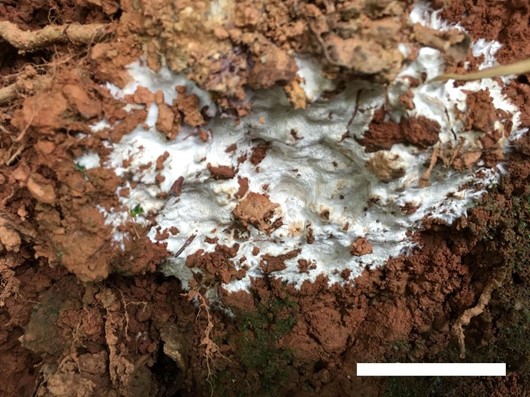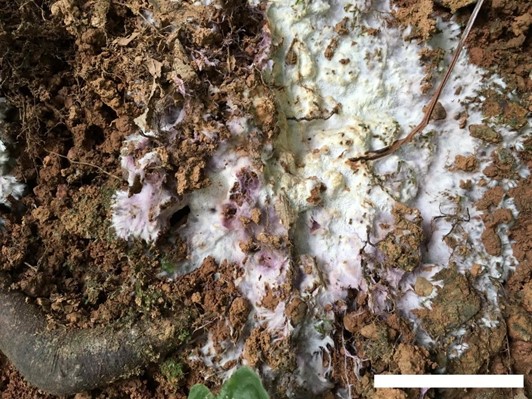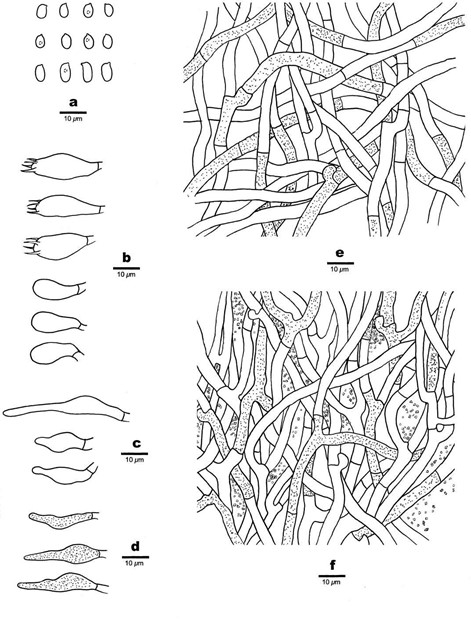Terrestriporia alba Y.C. Dai, B.K. Cui, F. Wu, Y. Yuan & Jia J. Chen, sp. nov. Figs 3-5
MycoBank number: MB 834545; Index Fungorum number: IF 834545; Facesoffungi number: FoF 09502;
Diagnosis – Differs from other poroid species of Russulales by its annual and resupinate habit, a monomitic hyphal structure with both simple septa and clamp connections, the presence of both gloeoplerous hyphae and gloeocystidioles, ellipsoid, hyaline, thin-walled, smooth basidiospores.
Type – MALAYSIA, Kuala Lumpur, Forest Eco-Park, on ground of a slope with some fine roots in the soil, 14 April 2018, Dai 18548 (BJFC026837, holotype).
Etymology – Alba (Lat.): referring to the species having white pores.
Fruiting body – Basidioma annual, resupinate, inseparable from substrate, soft and without odour or taste when fresh, soft corky when dry. Pore surface white when fresh, becoming buff when dry; margin distinct, fimbriate, concolorous with pore surface, up to 3 mm wide, thinning out; pores round to angular, 2–3 per mm; dissepiment thick, entire to slightly lacerate, cottony. Subiculum concolorous with pores, cottony to soft corky, up to 0.4 mm thick. Tubes concolorous with hymenophore, soft corky, up to 0.7 mm long.
Hyphal structure – Hyphal system monomitic; generative hyphae mostly simple septate, occasionally bearing clamp connections; all hyphae IKI–, CB–, frequently encrusted by fine crystals; tissues unchanged in KOH.
Subiculum – Generative hyphae hyaline, thin-walled with a wide lumen, frequently branched and simple septate, rarely bearing clamp connections, mostly smooth, rarely bearing crystals, interwoven, 3.5–5 μm in diam.; gloeoplerous hyphae present, almost the same size as generative hyphae.
Tubes – Generative hyphae hyaline, thin-walled with a wide lumen, frequently branched and simple septate, occasionally bearing clamp connections, frequently bearing fine crystals, interwoven, 2.5–4.5 μm in diam; gloeoplerous hyphae present, almost the same size as generative hyphae; gloeocystidioles present, fusoid, 17–40 × 4–7 μm; fusoid cystidioles present, hyaline, thin-walled, almost the same size as gloeocystidioles; basidia clavate to barrel-shaped, bearing four sterigmata and a basal simple septum, 18–27 × 5–8 μm; basidioles in shape similar to basidia, but slightly smaller.
Spores – Basidiospores ellipsoid, hyaline, thin-walled, smooth, IKI+, CB–, (4.1–)4.2–6(–7.2) × (2.8–)3–3.6(–3.8) μm, L = 5.08 μm, W = 3.11 μm, Q = 1.5–1.69 (n =90/3).
Specimens examined (paratypes) – MALAYSIA, Kuala Lumpur, Forest Eco-Park, on ground of a slope with some fine roots in the soil, 14 April 2018, Dai 18546 (BJFC026835), Dai 18547 (BJFC026836) & Dai 18556 (BJFC026845).

Figure 3 – Basidioma of Terrestriporia alba. Scale bar = 4 cm (Dai 18548, holotype).

Figure 4 – Basidioma of Terrestriporia alba. Scale bar = 4 cm (Dai 18547, paratype).

Figure 5 – Microscopic structures of Terrestriporia alba (drawn from the holotype). a Basidiospores. b Basidia and basidioles. c Cystidioles. d Gloeocystidioles. e Hyphae from subiculum. f Hyphae from trama.
